Learning how to share is a huge process that takes a long time. Luckily, in ten years of teaching children between the ages of 3-5, I have found that this timeline can definitely be speeded up by encouraging sharing in all its different forms.
This includes lots of games and activities that have sharing as their main focus, as well as the all-important praise and encouragement of sharing in play.
My top 17 sharing activities for preschoolers are:
1.Sharing Between Puppets
2.Feeding Monsters
3.Where Is It?
4.Pass The Smile
5.Pass The Potato
6.Change!
7.Pass Balls Round The Circle
8.Roll Ball
9.Fruit Salad
10.Mushroom
11.Snakes
12.Shark Attack!
13.Roll Ball Competition
14.Parachute Switch
15.Parachute Stories
16.Divers!
17.Encouraging Sharing In Play
I’m going to be showing you how to use parachutes, circle games, puppets, and more!
So let’s dive into the games:

1. Sharing Between Puppets
Children can often understand the concept of sharing first, if they themselves are taken out of the equation.
When children want something, it is quite an emotional response. It is hard to reason with their logic when they so passionately desire something all for themselves.
Puppets take away this emotional response, and get children to see sharing, and think about it in a logical way.
For this activity, you need at least two puppets. My all-time favorite puppet I have owned was a large monkey. Here he is in action:
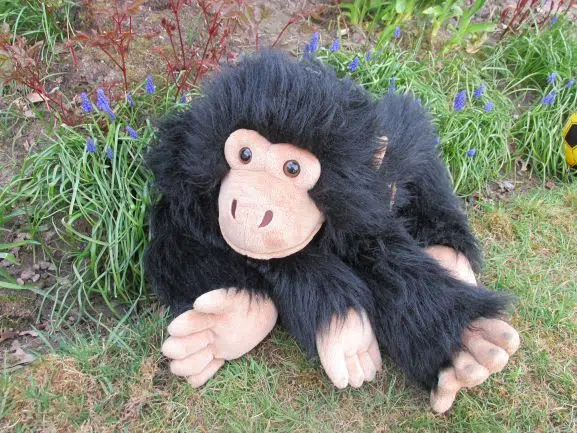
The hours of fun and learning that this monkey has generated is truly a thing of wonder. (You can check out the current price of one of these monkey puppets on Amazon here.)
As well as some kind of puppets, you also need something to share between them. It could be:
- Toy food
- Pretend sweets or chocolates
- Toys, like bears
- Something like gems or shells (such as these beautiful shells on Amazon)
- Or whatever else you can think of
The process now is to demonstrate how to share the objects between the two puppets.
One puppet gets the first object, and the second puppet gets the next. Keep repeating this process.
Then see if the children can mimic this process, splitting the objects fairly between the two puppets one at a time.
This is a great game for early counting and calculating skills, as well as being good for sharing. For other fantastic puppet games, check out my favorite 22 puppets games
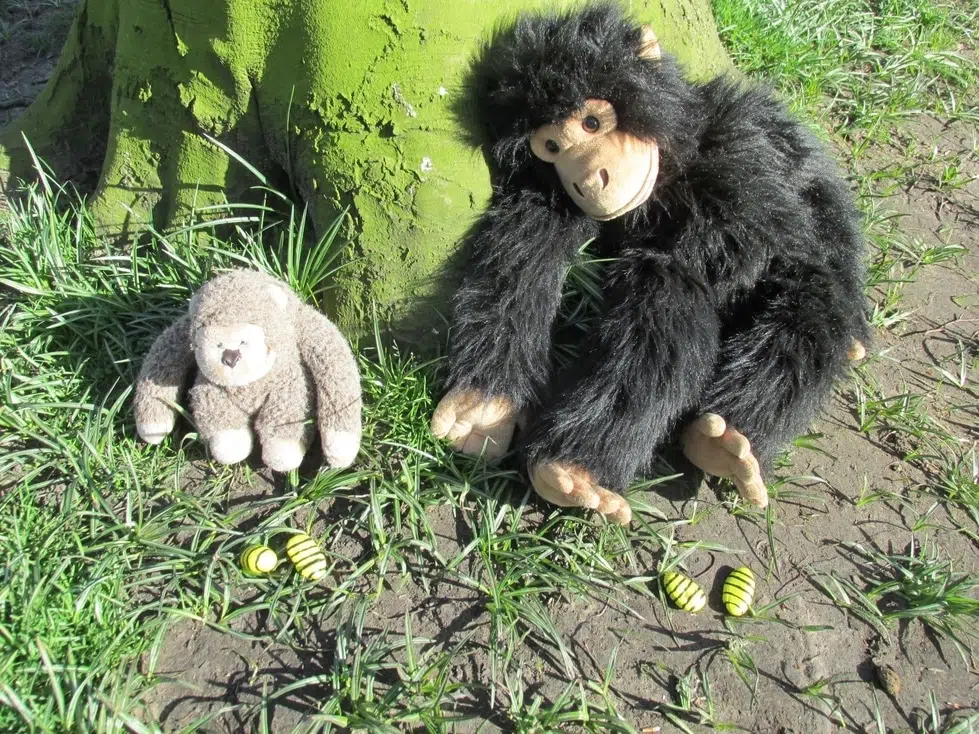
2. Feeding Monsters
For this game you need some kind of ‘monster’. This is basically just a box with a hole cut into it for the monster’s mouth. You could really jazz the monsters up, if you wanted, or it could be really simple.
Here is one that my colleague Kelly created:
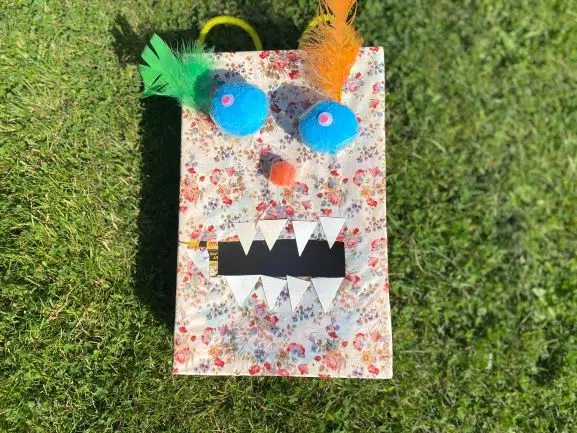
I’ve also made similar out of old boxes with a hole cut out. You could have any kind of character you liked on the box, particularly something that likes eating a lot.
So, something like a lion, alien, tiger, zombie, or anything else like that would be great.
Then get something to feed the monster with – it could be dried pasta tubes for example.
The idea is that one child at a time takes turns to pop a piece of ‘food’ into the monster’s mouth. Then the next child goes, and so on.
Very simple, but a good one for taking turns, and sharing the game.
You could have two monsters, potentially, and the children could help share the food between them, by feeding one, then the second, and continuing that pattern.
I also use a monster similar to the one in the picture for worry monster activities, a fantastic stress and worry reliever for young children.
Circle Games
Circle games are a fantastic way of sharing resources, as well as sharing other simple things like sounds, facial expressions, and even noises.
Here are some fantastic sharing circle games:
3. Where Is It?
For this you just need a circle of children, and one noisy instrument – something like a tambourine would be perfect.
One child volunteers to sit in the middle of the circle. They close their eyes (or they could potentially wear a blindfold if you think they are going to cheat).
The children in the circle pass the tambourine around from one to the other. Every time a child receives the tambourine, they give it a shake and then pass it to the next person that will do the same.
At any given moment, the adult is going to say, ‘Stop!’
Whoever has hold of the tambourine is going to hold it still.
The person in the middle of the circle is going to point to who they think is holding the tambourine.
4. Pass The Smile
This is another simple ‘passing’ circle game. It’s great for understanding emotions, eye-contact, and sharing all mixed together.
Everyone sits in a circle, and the adult starts by smiling at the first child in the circle. This child then ‘passes’ the smile, by smiling at the person sitting next to them.
The smile is passed all the way around the circle.
You can also pass around other types of facial expressions, such as a cross face, or a sad face.
This is a brilliant emotion game (check out the ultimate selection of emotion games here).
5. Pass The Potato
Here’s a circle game that is good for sharing an object.
All you need for this is one potato (which the children find quite funny), and also some music as well.
The game works a bit like pass the parcel. Put the music on, and the children pass around the potato. When the music stops, that person is either the winner, or they are ‘out’ (depending on which version of the game you would prefer to do.)
6. Pass Balls Round The Circle
This is a really simple game that even very young children can access.
You need some kind of large ball for this. In the very simplest version of the game, all you do is sit in a circle, and pass the ball around.
You could make it trickier if wanted by adding a few balls to mix, and pass them all round in the same direction, round and round the circle.
7. Change!
This is how to extend the simple ball pass game above.
Now it is good to have two different colors of balls – for example, have two blue balls, and two red balls.
A couple of packs of knobbly balls is my new favorite choice for this kind of activity. These balls are knobbly and great for sensory learning. (Check out the latest price on Amazon here).
Start with one blue ball, and one red ball.
The blue ball gets passed one way around the circle, and the red ball gets passed the opposite way. The tricky job is when the balls swap over each other at some point.
To make it even trickier, at any given moment, say, ‘Change!’ The balls swap directions and head back the opposite way.
Make it trickier by adding more balls – for example three going one way (all blue), and three the other (all red).
When they are up and running, try saying ‘Change!’
To find out lots more fantastic circle games such as this, then check out my ultimate 21 preschool circle time games (that actually work!)
All of these games feature in my book 101 Circle Time Games…That Actually Work!
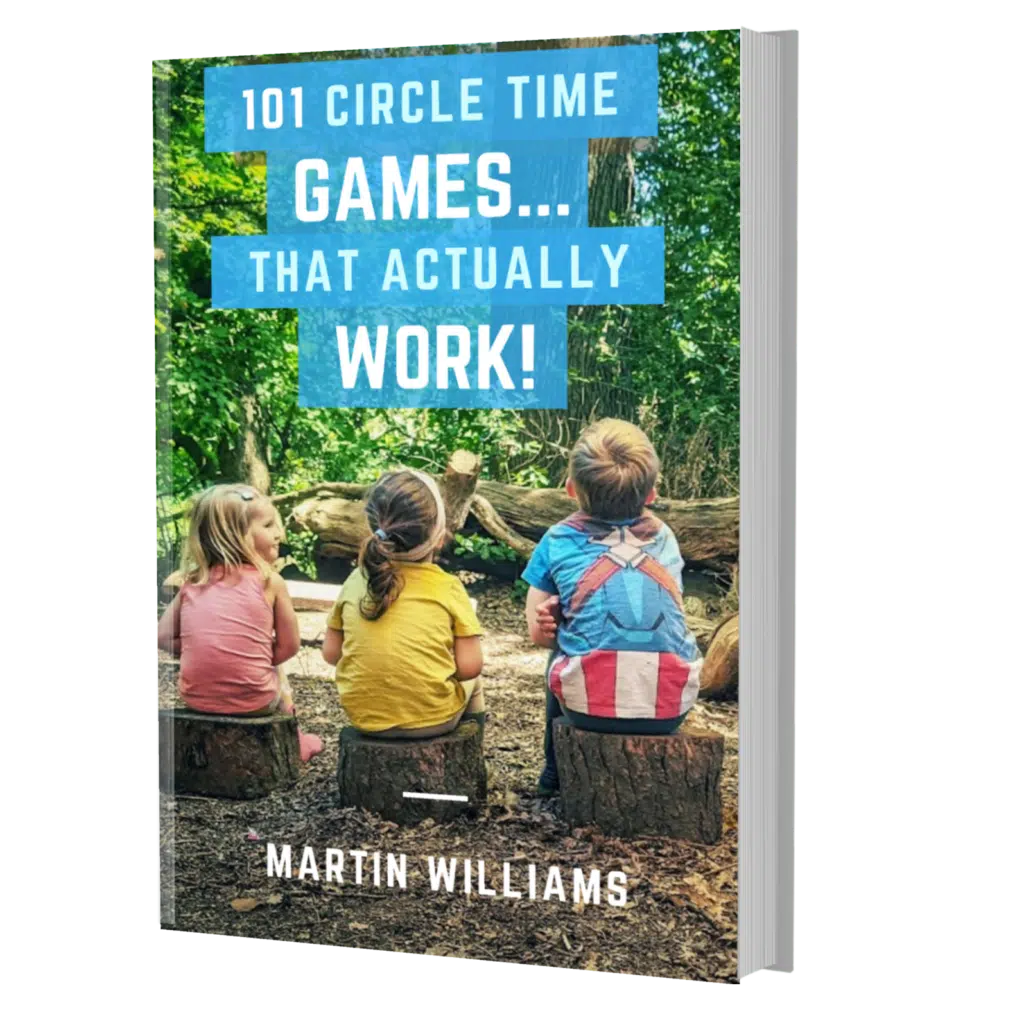
This book contains:
-All the very best phonics circle time games
-Math circle time games
-Emotion and mindfulness circle time games
-Literacy circle time games
-Active and physical games
-And so much more!
You can check out 101 Circle Time Games…That Actually Work here.
Parachute Games
Large parachutes are another fantastic tool for helping children to share experiences and resources.
The parachute I use looks like this:
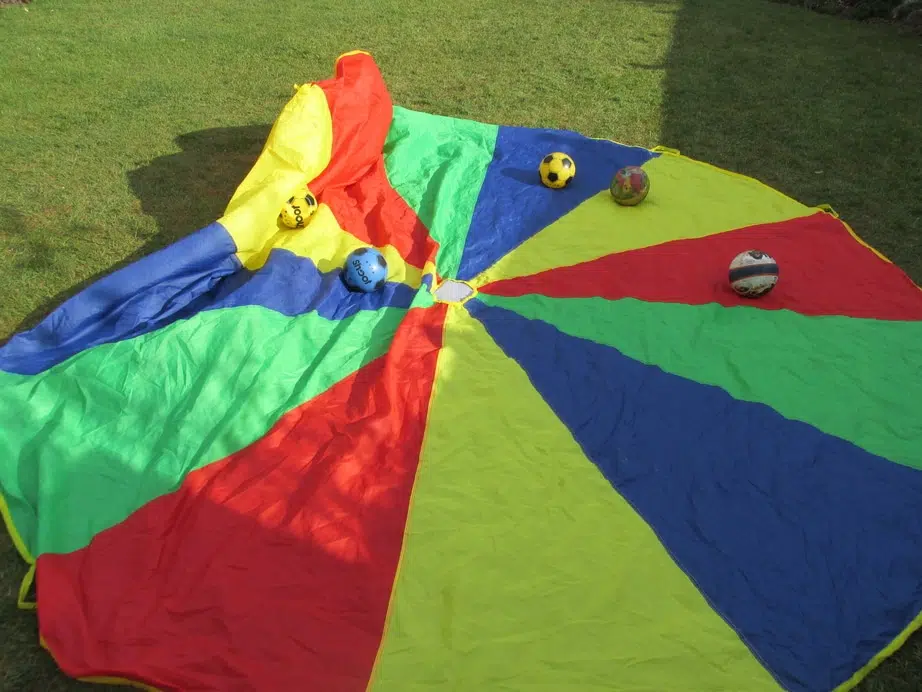
You can check out the latest price on Amazon here.
Try some of these brilliant parachute sharing activities:
8. Roll Ball
Get a large rubber ball and place it on the chute, quite close to the edge.
All stand up with parachute. The idea is to roll the ball around the edge of the chute, in a wide circle, all helping to keep it from rolling off.
Can you do a few rotations of the parachute?
This game really gets them all working as a team, and sharing the chute.
9. Roll Ball Competition
If you want to get a bit of competition into the sharing experiences, then this game is the competitive version of the ‘Roll Ball’ game.
Pick a line that is going through the middle of the parachute, and everyone to the left of it are on one team, and everyone to the right are on the other.
The idea is that the people on one team are going to be trying to roll or bounce the ball off the chute on the other team’s side. That team are going to be trying to bounce it off the opposite side to them.
If you manage to bounce or roll the ball off on your opponent’s side, then your team win a point. You could do first to 3 or first to 5.
10. Mushroom
This is a great game for sharing and teamwork.
All stand up, holding the parachute in a circle.
Everyone says, ‘1, 2, 3, Lift!’ They lift the chute up at the same time, and it balloons up into a big ‘mushroom.’
You can also do ‘Mushroom Hide’. This is basically the same, but this time when you lift up the chute, you all move forward and crouch down. The parachute will settle over the tops of you in a big mushroom shape.
11. Snakes
I’ve no idea why or how this one works, but it really does!
What you need is about 6-10 pieces of string that are each about 2 feet long. These are the ‘snakes.’
Everyone stands up, holding the parachute, and throw these pieces of string onto the chute. Make sure to spread them out!
The idea of the game is to wiggle and jiggle the chute, and after a few moments, some of the ‘snakes’ will start to stick together!
They all get tangled up, and the goal is to get all the snakes stuck together in a big ball.
Sometimes this can take a while, but it really gets everyone working together and sharing the experience.
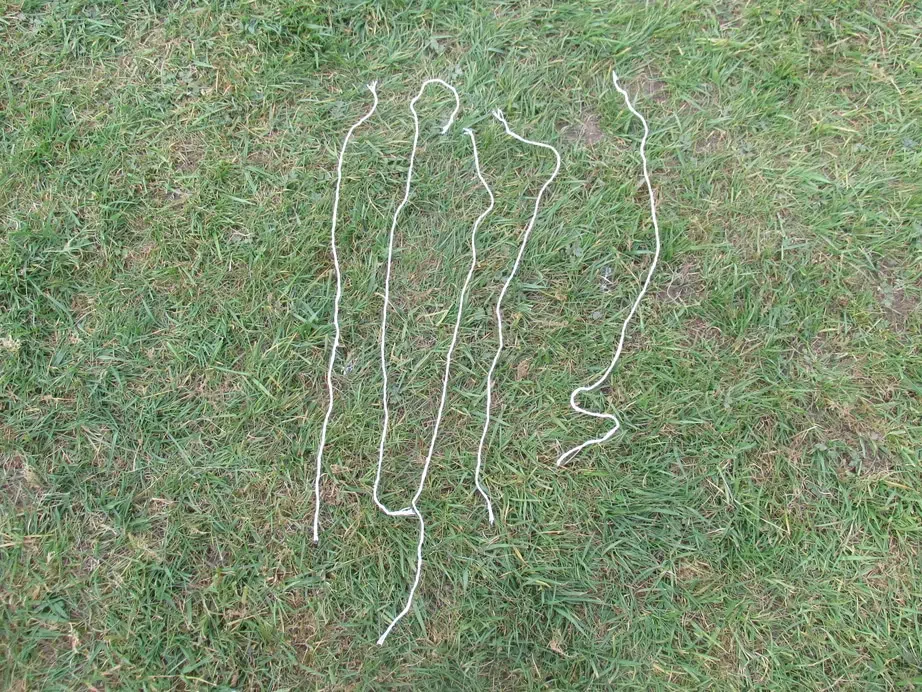
12. Fruit Salad
Of course, this game is an absolute classic. It is good for sharing, because there will be more than one child that is allocated the same fruit. Children have to understand that other children can have the same fruit as them – it is not just their alone!
Stand around the parachute, and give everyone a fruit name. I normally go round, pointing at each child in turn, and saying something like ‘strawberry, banana, apple, strawberry, banana, apple…’
Three or four fruits is normally the way to go.
Then, when (hopefully) everyone knows what fruit they are, everyone goes, ‘1, 2, 3, lift!’
All lift up the parachute, and the adult shouts out a fruit name.
For example, call out ‘banana’.
While the parachute is still in the air, all the ‘bananas’ are going to run underneath it, and run to one of the now vacant positions that another child has just left.
Then repeat the process with the strawberries and the apples.
13. Shark Attack!
This is a fun parachute game, that has a bit of an element of sharing in, as the children all manipulate the chute together.
One child volunteers to be the ‘shark’. They are going to hide under the parachute.
Everyone else is going to make gentle ‘waves’ on the sea, by wafting the parachute up and down.
The shark is going to pick someone to ‘eat’. They do this by (gently) tapping someone on the shoe. That person now becomes the shark.
Encourage gentle shark-attacks in this game!
14. Parachute Switch
This is a good game for swapping (and sharing) places with another child. Some children get a bit territorial about their space or where they are standing, so this one is good for them.
This is also a simpler version of the fruit salad game, particularly good if the children can’t remember what fruit they are.
Simply stand around the parachute, and all say, ‘1, 2, 3, Lift!’
Everyone lifts the chute high in the air.
The adult calls out the names of two people in the circle. For example, they might say, ‘Sarah and Usman.’ Those two children will run under the chute and swap places.
Then repeat the game again.
If the children are having problems with reacting in time, then you can nominate the children before you lift the chute up, to give them plenty of time to respond.
15. Parachute Stories
Parachutes are wonderful for early literacy and storytelling.
These games also help children work together as a team, and share a big resource (the parachute).
In this, the adult makes up a story, and you all help to move the parachute in a way that brings life to the story.
For example, it might be about a girl that goes on a ship on the sea. Everyone moves the chute up and down like the waves on the sea.
There’s a storm (violently go up and down). But then the waves subside (much smaller waves).
She sees a large eagle in the air, beating its wings (move the chute up and down, as the bird moves its wings).
She sees a large giant stamping on the beat (the chute goes up and down in time with his feet).
All this kind of thing. Just make it up, and the children can add their ideas into the story too.
16. Divers!
This is another great parachute game, that encourages them all to share as they lift the chute as part of a team.
Everyone stands around the parachute, and underneath it is the ‘sea’. Under the sea you are going to have some objects.
You could have these in a box (something like a treasure chest would be amazing), or you could just have them on the floor.
Objects could be whatever you think – maybe a few toys would work well.
Pick one child to be the first ‘diver’. Everyone goes ‘1, 2, 3, lift!’ and they lift the parachute up.
The adult says what the diver will pick up from the sea-bed, for example a ‘bear’. The ‘diver’ runs under the parachute and gets that object, and brings it out to ‘safety’. Then the next child goes.
You can find the greatest 40 parachute games ever in my article here.
17. Encouraging Sharing In Play
Of course all the activities and games you can play that supports sharing, are just a pre-cursor for children actually sharing in their play.
This is the biggie!
There are lots of learning areas that really help and support children in sharing with others.
Some of these include:
Construction – Building models with others really supports sharing of ideas and resources
Sand play – Once again this really helps them to share talk, objects, and narratives
Water play – Sharing boats, containers, pouring equipment, toys, and anything else they might be using.
Children learn to share through a whole range of ideas – both led by adults, and child-led as well.
Final Thoughts
Learning how to share is a huge skill that takes some children many years. It is a long process, but one you can speed up by using some fun games, resources, and ideas.
If you’ve found this article useful, another one that you will enjoy is 17 Active Listening For Kids.
